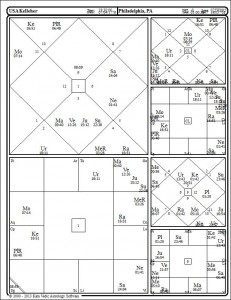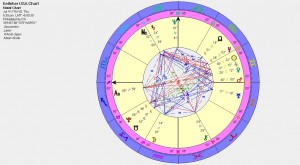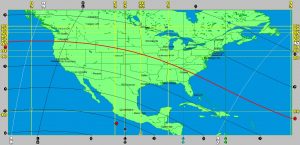One of the most significant events of 2015 is happening in September as the United States enters a new “mahadasa” (major karmic period, or great cycle) as seen through the United States Kelleher chart. Of the many different astrological birth charts used to read the collective karma of the United States, this one was rectified very precisely by contemporary Vedic astrologer James Kelleher for July 4, 1776 at 18:30 in Philadelphia, PA USA, giving a rising sign (lagna or ascendant) at nearly 9 degrees sidereal Sagittarius.

 According to the Kelleher chart, the United States is in a state of major flux and frequency shift because it will begin a new 18-year Rahu major period in the Vimshottari dasa beginning on September 25, 2015, as calculated based on the Moon, Lahiri ayanamsa, and a 365.2422-day saura year using the Kala-Vedic Astrology Software program. The Vimshottari is one among a great variety of Vedic astrology’s progressed cycles known as “dasas” which track the unfolding of karma (actions, events), and is considered the most important dasa for individuals in the current age.
According to the Kelleher chart, the United States is in a state of major flux and frequency shift because it will begin a new 18-year Rahu major period in the Vimshottari dasa beginning on September 25, 2015, as calculated based on the Moon, Lahiri ayanamsa, and a 365.2422-day saura year using the Kala-Vedic Astrology Software program. The Vimshottari is one among a great variety of Vedic astrology’s progressed cycles known as “dasas” which track the unfolding of karma (actions, events), and is considered the most important dasa for individuals in the current age.
Many well-regarded astrologers use the Vimshottari for not only individual charts but also mundane (world) horoscopes such as those of corporations, businesses, organizations and nations. However, there are some esteemed astrologers who argue that the Vimshottari dasa is to be used for individuals only, not for the other kinds of non-human entities we are analyzing in mundane horoscopes; these same astrologers often choose to use alternative dasas and techniques for mundane astrology.
Further, some astrologers do not advocate using a founding chart for a country at all, and instead use lunation charts, or perhaps they use the natal horoscope of the current president. I know of at least ten horoscopes for the United States, such as the Declaration of War chart for July 6, 1775 at 11 AM, or the charts for either the signing or the ratification of the Articles of Confederation. Some use the Declaration but prefer different times for the signing (e.g. Sibley at 5:10 PM, or one from my friend Barry Rosen for 6:17 PM). One school of Indian-based Vedic astrologers prefers a more recent progressed chart from the 1800s; and some use a combination of different methods and charts.
I believe that various points of view in astrology are valid, but I have seen enough evidence to be quite comfortable trusting 1) the Vimshottari dasa for mundane charts in general, and 2) the Kelleher chart for reading karma of the United States. And I always use the sidereal zodiac, not the western tropical system. The sidereal system is used in traditional Vedic astrology as well as in western sidereal astrology of the Babylonian tradition. I personally find it more accurate for my own work.
The premise of the Kelleher chart is that the United States was officially “born” at the time of the signing of the Declaration of Independence on July 4, 1776, with the official time of signing rectified to 6:30 PM in Philadelphia, which puts the US chart in the Rahu-Rahu dasa at the time of founding, meaning in the main and first sub-cycle (bhukti-S.India or antardasa-N. India) of Rahu, the Moon’s North Node. This is because the Vimshottari cycle starts at the time and date of birth of a person or other entity with the lord of the Moon’s nakshatra. The Moon’s nakshatra in the United States chart is known as Satabisha (in sidereal Aquarius), and this nakshatra is ruled by Rahu.
Thus the collective consciousness of the United States was profoundly conditioned at its foundation by Rahu, who is an outsider, immigrant and rebel, just as the early settlers and founders of America were. Rahu as lord of Satabisha nakshatra is the over-lord of the Moon, which represents the public and the homeland. Rahu is also placed in sidereal Cancer which is ruled by the Moon, and in the 8th house which also relates to rebels and revolutions!
The Vimshottari dasa runs for 120 years and follows a particular order for every chart: Ketu (7 years); Venus (20 years); Sun (6 years); Moon (10 years); Mars (7 years); Rahu (18 years); Jupiter (16 years); Saturn (19 years); and Mercury (17 years). As mentioned, the ruler of a birth or inception chart’s Moon nakshatra (janma tara) determines where the cycle begins, i.e., the lord of his or her particular birth dasa starts the cycle, and the zodiacal degree of the Moon determines the balance of years in that cycle, and then from there, it runs in the same order for any chart.
The United States had 18 years of Rahu mahadasa from 1776-1793, during which time it was coping with a war and then with the economic and cultural after-effects of war when it was finding its identity as a new nation. The period was characterized by massive war debt and inflation, political transformation, and western migration, all of which are specific significations of Rahu and also of the 8th house of the astrological chart which Rahu occupies.
Rahu dasa came around again 120 years later, for the second time, from 1895 to 1913. This was a period of political reform and technological (industrial) revolution in the United States. One thing we can accurately predict for a Rahu cycle (especially when Rahu is in the 8th house of the astrological chart in Cancer) is a tendency for more fear than usual in the collective mind; an upsurge in sensationalist media; potential for revolutionary socioeconomic changes; an explosion of scientific and technological discoveries; mass migrations; civil and international wars; and a cultural rebirth with a restructuring of social mores and traditions.
The last American Rahu mahadasa saw the 1896 election of US President McKinley, who was later assassinated by a Polish anarchist in 1901. Other defining events include the Spanish-American War, expansion of US territories and the Panama Canal; political reforms; civil rights difficulties; the imposition of a gold standard (dropped later in 1933); technological revolution; massive immigration; growth of labor movements; closing of the frontier; populism; progressivism; high tariffs and taxes; big stick diplomacy; and yellow journalism. No massive economic or social collapse occurred in the Rahu dasa (as has been predicted by some for this coming Rahu cycle).
Yet, a financial panic actually did occur halfway through Rahu dasa in 1907. And also quite interestingly, in the chidra dasa (“hole” or edge of the adjustment period near the beginning of a dasa) of Rahu in 1895, JP Morgan led a bond offering that rescued America from a severe two-year depression. This was an unprecedented reverse buyout of the government by one man, which makes one wonder if similar kinds of epoch-making events will occur in American culture, government (politics), or economy in the coming years.
It appears that during much of the Rahu period, America could be in for some serious surprises and possibly some danger, cultural and political turmoil, a health or healthcare crisis, and/or uncovering of deception, plots, and scandals in government and politics. All this is even truer as the Kelleher chart Neptune will be widely eclipsed close to the beginning of the dasa (known as the “dasa pravesh”), on September 13, and will be further triggered through the spring of 2016 by the transit of Rahu over Neptune, and then over the September 13 Leo eclipse points through March 2016. In 2017, the U.S. chart Moon will be eclipsed by Ketu, indicating domestic changes and civil strife.
The following summer, a solar eclipse will occur over America, in August 2017, which will, both literally and metaphorically, split America into two, indicating that in 2017 and for the next three years, the U.S. will be going through a great deal of upheaval. I mention that it will be “for the next three years,” as the eclipse duration is 2 and 2/3 minutes, indicating it will have a resonating impact for at least 2 and 2/3 years, which will extend into the third quarter of 2020.
 Rahu is a chaya graha or shadow planet and so he represents what is hidden, such as what conspiracy theorists surmise is a corrupt secret shadow government operating behind the scenes. In Rahu’s great cycle, such shadows can also be revealed more clearly for those who choose to see. In addition, Rahu is in a powerful transit in the 10th house (government) of the Kelleher chart at the dasa pravesh (beginning of Rahu mahadasa) which points to a Rahuesque character or characters dominating America’s presidential political race. What (or who) is that, you might wonder? Rahu here could have a variety of expressions. It might be a Washington outsider or outsiders, or perhaps it could be an insider calling for a “political revolution in America.” A Rahu type often has an unconventional message and style, and even an extreme political ideology.
Rahu is a chaya graha or shadow planet and so he represents what is hidden, such as what conspiracy theorists surmise is a corrupt secret shadow government operating behind the scenes. In Rahu’s great cycle, such shadows can also be revealed more clearly for those who choose to see. In addition, Rahu is in a powerful transit in the 10th house (government) of the Kelleher chart at the dasa pravesh (beginning of Rahu mahadasa) which points to a Rahuesque character or characters dominating America’s presidential political race. What (or who) is that, you might wonder? Rahu here could have a variety of expressions. It might be a Washington outsider or outsiders, or perhaps it could be an insider calling for a “political revolution in America.” A Rahu type often has an unconventional message and style, and even an extreme political ideology.
As Rahu rules mass media, this person could be quite entertaining and a master of media manipulation, good at rattling cages, and not doing and saying the same old broken things. A Rahuesque person might seem radical, rebellious, unabashed, moody, changeable, confident, eccentric, brash, unrealistic, driven, ambitious and successful in a worldly way. A Rahu character will evoke intense positive or negative reactions from those in the public and the media. At the least, Rahu in the 10th house of the dasa pravesh nearly promises that this current presidential race will probably develop in the most unexpected manner with many shocking twists and turns. With Rahu, you can be sure that all is not as it appears.
Rahu is the graha in Vedic astrology which ultimately has to do with evolution, and his nature is to expand and transform. The beginning of Rahu mahadasa is often said to bring about some very difficult conditions, but in this case it may not necessarily be so since Rahu is transiting in one of its more favorable signs and houses (Virgo, 10th) at the dasa pravesh, which can indicate a cycle of gradual improvement for America and its government. It is significant that the Rahu cycle starts out between two eclipses and very close to the super-Moon total lunar eclipse on the 27th-28th September, giving some sense that Rahu mahadasa could mark a dramatic and significant period in history.
In mundane astrology, Rahu relates to (among other things) immigration, migrants, outsiders, and untouchables; debts; upheaval; politics, secret deals, plots and assassinations; chemicals and poisoning; health epidemics (like cancer and viral pandemics); banishment; tyranny; war; violence; strikes; technology; space travel and aeronautics; litigation; and mass media, advertising, and public relations. Please hold onto your hats and get ready for the wild ride of Rahu who stirs the stormy seas and brings forth all kinds of new and rare evolutionary challenges and opportunities.
